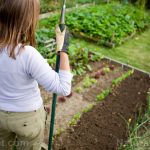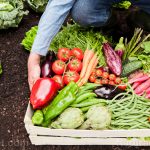
Home gardening tips: A beginner’s guide to composting
Friday, May 06, 2022 by Zoey Sky
http://www.naturalnewstips.com/2022-05-06-home-gardening-tips-guide-to-composting.html

Composting at home is good for your garden, the soil, your crops and the planet. It is a great way to repurpose food waste and improve soil quality in your home garden. If you’re curious about composting, read on for tips on how to get started. (h/t to Milkwood.net)
Composting refers to the process of actively feeding many microorganisms the right ingredients in the right amounts so they can multiply and produce nutrient-rich humus called “compost.” Once you have compost, you can use it to improve soil quality and grow healthier plants.
Addressing food waste with composting
Food waste is a worldwide problem. Unfortunately, it starts where the food is grown. Data suggests that at least 25 percent of all vegetables produced don’t even leave the farm.
Once the food reaches consumers, a lot of it still gets thrown away. In Australian households, families throw away a shocking 3.41 million tons of edible food annually.
Most of the food that’s thrown away also goes straight to landfills where it rots and becomes anaerobic. This means the organic material is turned into the greenhouse gases methane and carbon dioxide. Methane is 25 times more harmful to the atmosphere than carbon dioxide.
Food waste also causes issues with odor, leaching, attracting vermin and is a potential source of disease. This is where composters can help.
The benefits of composting
Compost helps produce healthy soil, healthy food, healthy humans and less food waste. Aside from improving soil quality, composting also helps lock up carbon in the soil.
First, compost creates humus, which consists of long chains of carbon atoms that last a long time in the soil. When compost is added to soil, the soil becomes healthier with improved structure and increased biological activity. This means the plants growing in soil with compost become healthier and their capacity to photosynthesize is increased so they can capture and sequester more carbon from the air and store it in the soil.
The cycle continues: When you eat healthy food from healthy soil, you can use the food scraps to make more compost. (Related: Home gardening basics: How to remove worms from your compost pile.)
Composting dos and don’ts
Composting may seem confusing, but you can get used to it once you learn what to do and what not to do.
First, learn what can go inside your compost bin. There are different systems, techniques and recipes to make compost, but they all have four ingredients in common: carbon materials, nitrogen materials, water and air.
Carbon materials are dry and brown like straw, dead leaves, shredded office paper or newspaper with soy-based inks, sawdust and cardboard. Don’t use glossy paper for your compost.
Nitrogen materials, meanwhile, refer to fresh materials like food waste, green grass clippings, some animal manures and seaweed.
You need to learn which carbon and nitrogen materials are safe to put in a home compost, and how to mix them up at an appropriate ratio to keep the compost microorganisms healthy.
Almost all kinds of food scraps can be used as a valuable source of nitrogen for your compost bin, tumbler or bokashi bin, but there are some things to avoid.
Food scraps you can add to a compost
- All fruit and vegetable scraps
- Bread
- Coffee grounds and tea leaves
- Cooked leftovers
- Crushed eggshells
- Dairy
- Nut shells
- Small amounts of meat (Remove big bones.)
- Small amounts of cooking oils
Note: Chop up food waste into the size of a small coin to accelerate the composting process.
Food scraps you shouldn’t add to a compost
- Citrus skins – Don’t add too many citrus skins because they can make your compost too acidic.
- Large bones – Large bones take a long time to break down.
- Teabags – Many teabags contain polypropylene plastic to keep the tea bags from falling apart. If you’re using teabags, get a plastic-free brand or use loose leaf tea.
- Wood ash – Wood ash from a fire is an alkaline material. Adding in a small amount is fine, but using too much can make compost too alkaline for general food production, which should be around a neutral pH of 6.5.
Carbon materials for your compost bin
- Aged sawdust
- Brown cardboard.
- Newspapers that use soy-based ink
- Shredded office paper
- Straw
Notes: Don’t use glossy magazines or brochures since chemical inks can compromise the compost’s health. Place a weatherproof bin storing dry carbon materials directly next to your compost bin. This makes it easier to add a carbon layer each time you add your food scraps.
Things you should never put in a compost
- Diseased plants
- Plastics
- Ivy, gorse, thistles, twitch grass and other runner grasses and weedy plants
Other things to add to your compost
- Comfrey, dandelion, plantain, stinging nettle and yarrow are compost activators or nutrient-dense ingredients that you can add to your compost system in modest amounts.
- Add small amounts of “rock dust” to remineralize the soil. You can get rock dust from nurseries and some quarries. Use a quality product that’s specifically for food production.
The compost “carbon to nitrogen” ratio
Compost contains both nitrogen or “green” ingredients and carbon or “brown” ingredients.
With the exception of worm farms, most compost systems require a carbon to nitrogen ratio of about 25:1 or 30:1. For best results, learn how carbon-y or nitrogen-y different compostable materials are so you know how much of each to add to your compost bin to create a thriving environment.
The table below shows which things are very high in nitrogen, and carbon.
Format = Inputs – Carbon to nitrogen ratio
- Fish guts –10:1 (Very high in nitrogen.)
- Chicken manure – 10:1
- Mixed, fresh food scraps – 15:1
- Fresh grass clippings – 15:1
- Fresh cow manure – 17:1
- Fresh horse manure –27:1
- Pea straw – 40:1
- Wheat straw – 50:1
- Newspaper – 60:1
- Cardboard – 100:1
- Draw Sawdust– 200:1 (Very high in carbon.)
Compost bin options
Compost needs to be stored in a compost bin so you can build your compost pile and store food waste and other organic materials while they’re composting.
Here are three types of compost bins that suit different reasons in different contexts:
Black compost bin
Black compost bins sit directly atop the soil and are popular because they are easy to use. These bins are a cold compost (mesophilic) system that are smaller than one cubic meter.
How to use a black compost bin:
- If you have a small compost bin, layer carbon and nitrogen materials. Start with a 15-cm layer of carbon, then add a seven-cm layer of nitrogen (like mixed food scraps). Repeat until the bin is full.
- Add water between each layer as you go.
- When the compost bin is done, every time you put a bucket of food scraps in add two buckets of carbon materials too.
- Don’t add weedy or diseased plants to a cold compost system.
Compost tumbler
Compost tumblers are a great option if you have limited space, rodent problems, or if you need an ergonomic option that limits bending and lifting.
A compost tumbler is a fully sealed container that can be rotated to mix the composting materials. The sealed container also helps contain the heat generated by the composting process, which helps speed up the process of converting kitchen and yard waste into compost.
Note that tumbling composters are different from compost bins. The latter were designed to be set on the ground and most compost bins have open bottoms.
Bokashi bin
Bokashi is Japanese for “fermented organic matter” and these small bins are designed to be used right in your kitchen if you want.
The system includes a purpose-made bucket with a lid and drainage tap. They come in different sizes and can contain up to 20 liters in volume.
The kit also comes with a dry bran mixture made from rice husks and wheat that has been inoculated with beneficial microorganisms.
These microorganisms ferment the food scraps, eliminate any bad smells and are a biologically active living material that can eventually be transferred to your garden to finish composting in the ground, where they can improve soil health.
If you want a more fruitful garden, start composting and help reduce food waste.
Watch the video below for tips on how to work with compost.
This video is from the Cahlen channel on Brighteon.com.
More related stories:
Homesteading 101: Using chickens to help manage your compost.
Top 6 organic fertilizers for your garden.
For the organic farmer: Grow healthier plants with organic fertilizer mixed with compost tea.
Sources include:
Tagged Under: Tags: compost, composting, environment, gardening tips, goodpollution, green living, harvest, home gardening, homesteading, how-to, off grid, organic farming, preparedness, prepper, prepping, tips
RECENT ARTICLES


Home gardening tips: A beginner’s guide to composting
By Zoey Sky

Emergency shelter essentials: 7 Things you need for hassle-free off-grid living
By Zoey Sky

SHTF essentials: 7 Alternate power sources for emergencies
By Zoey Sky

Food supply tips: 9 Ways to preserve meat at home
By Zoey Sky
COPYRIGHT © 2017 NATURAL NEWS TIPS


